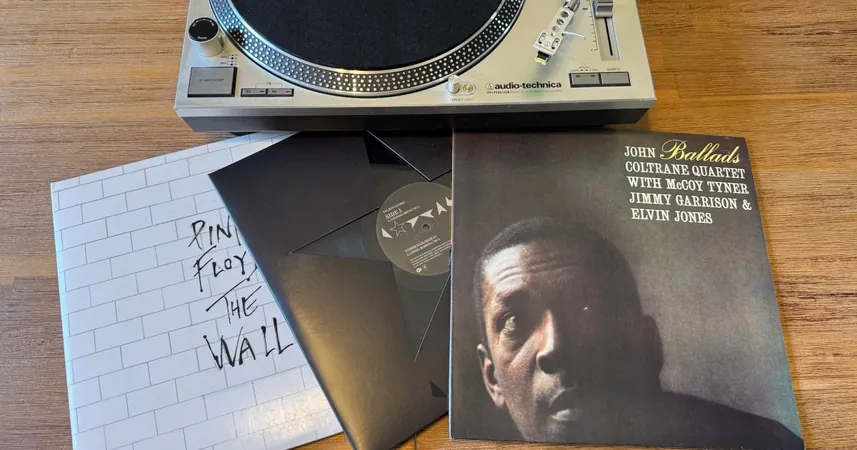
The Vinyl Dilemma: Unveiling the Myths Behind The Beloved Medium
2025-01-22
Author: Yan
The Vinyl Revival
In recent years, a vinyl revival has swept across music lovers worldwide, igniting passionate debates regarding the superiority of analog over digital formats. Audiophiles often advocate that vinyl records deliver a “warmer” sound, arguing that digital audio—characterized by its discrete, stair-step waveform—fails to capture the smooth and continuous signals embodied in traditional analog recordings. However, this notion rests on misconceptions that have been circulating for decades.
Analog vs. Digital
The reality is that from the inception of modern recording practices, there has been a complex interaction between analog and digital technologies. Despite the allure of all-analog production, the truth is that very few recordings are purely analog today. Most vinyl records you spin share a common thread—they have traversed through various digital stages, from recording to mixing and mastering.
Advancements in Digital Audio
Over the decades, significant advancements in digital audio technology have proved beneficial for musicians and producers alike. The dynamic range offered by digital recording equips artists to capture the wide spectrum of sounds necessary for an orchestral performance—qualities that are difficult, if not impossible, to achieve with analog alone. As the 90s introduced digital audio workstations (DAWs) into studios, producing music entirely in analog became increasingly rare. Many schools still teach historical analog techniques, but the shift to digital is undeniable, given the creative efficiencies it provides.
The Challenges of Purely Analog Recording
Fast forward to 2025, the complexity and costs associated with creating a purely analog recording are daunting. The equipment demands ongoing expert maintenance, and the scarce magnetic tapes required for high-fidelity recordings render analog methods almost impractical in today’s fast-paced music industry. Digital tools and instruments have become integral components of the recording process, fundamentally altering how music is made.
The Importance of Digital in Vinyl Production
Amidst ongoing debates over audio fidelity, one critical question arises: Does the digital component in vinyl production matter? While many audiophiles insist on pure analog recordings, it’s essential to recognize that when digital technology is seamlessly integrated into the production chain, the differences may be nearly imperceptible to the average listener. A significant controversy involving Mobile Fidelity Sound Lab raised eyebrows when it was revealed that their so-called “all-analog” vinyl records were produced using DSD files. Yet, the more telling question remains—did anyone notice a difference before the revelation? Likely not.
The Ritual of Vinyl Listening
What complicates the matter further is the ritualistic experience associated with vinyl. Many listeners cherish the tactile nature of handling records; the anticipation of carefully removing an LP from its sleeve while reveling in its artistic design adds layers of meaning beyond mere sound quality. We engage deeply with the craftsmanship of albums, savoring the holistic narrative presented by artists—from conceptual rock operas like Pink Floyd’s *The Wall* to intimate explorations such as David Bowie’s *Blackstar*.
Conclusion: The Artistry Beyond Format
Ultimately, whether a recording has been touched by digital technology does not diminish the emotional resonance of the music. The essence and magic of the compositions exist independently of the medium. For those who truly appreciate music, the ritual of immersing oneself in a record—a tradition that transcends technological debates—remains profoundly fulfilling. So the next time you drop the needle on a vinyl record, remember: the artistry and soul of the music triumph over the format itself.





 Brasil (PT)
Brasil (PT)
 Canada (EN)
Canada (EN)
 Chile (ES)
Chile (ES)
 Česko (CS)
Česko (CS)
 대한민국 (KO)
대한민국 (KO)
 España (ES)
España (ES)
 France (FR)
France (FR)
 Hong Kong (EN)
Hong Kong (EN)
 Italia (IT)
Italia (IT)
 日本 (JA)
日本 (JA)
 Magyarország (HU)
Magyarország (HU)
 Norge (NO)
Norge (NO)
 Polska (PL)
Polska (PL)
 Schweiz (DE)
Schweiz (DE)
 Singapore (EN)
Singapore (EN)
 Sverige (SV)
Sverige (SV)
 Suomi (FI)
Suomi (FI)
 Türkiye (TR)
Türkiye (TR)
 الإمارات العربية المتحدة (AR)
الإمارات العربية المتحدة (AR)